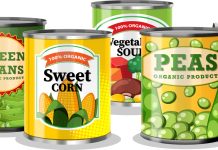
Over the last decade, consumers showed an increasing attention towards a healthy diet and a correct lifestyle. According to the WHO, in fact, an inadequate diet negatively affects the psychological and physical well being, and can trigger a variety of non-communicable diseases, as diabetes, cardiovascular diseases and cancer.
Against this background, it has been demonstrated that the Mediterranean diet, combined with adequate physical activity, allows to maintain a correct and balanced lifestyle. The Mediterranean diet is characterized by a large consumption of fruit and vegetables that provide beneficial substances for the body, such as vitamins, minerals, phytochemicals and fiber. The fiber consists of polysaccharides of vegetable origin, resistant to the digestion of our gastrointestinal tract.
As fiber is not fully digested, it cannot be considered a real nutrient, but it is very important for our metabolism, as it retains liquids and reduces the absorption of lipids and sugars in the blood. Susceptible to bacterial fermentation in the intestinal tract, it can contribute to the maintenance of a proper micro-biota and prevention of certain colon disorders. However, the effect can vary greatly depending on the type of fiber, which includes an extremely heterogeneous group of compounds, some soluble and others insoluble in water.
Among the various definitions of edible or dietary fiber proposed over the years, in 2006 the Codex Alimentarius defined it as “carbohydrate polymers with a degree of polymerisation not lower than 3, which are neither digested nor absorbed in the small intestine”.
Fibers from agro-food by-products
Today the market offers a wide range of fibers, characterized by various physical-chemical properties and from different sources. The fibers traditionally used in the food industry come from cereals, but even fruit and vegetable fibers have interesting nutritional and technological properties.
The latter tend to have a more balanced relationship between soluble and insoluble fiber in terms of nutritional requirements, although specific technological properties (such as solubility, water absorption, swelling or oil retention capacity) are required depending on the specific food application. These fibers can be obtained even from by-products of the agro-food industry, one of the possible strategies for improving the sustainability of the food system.
Around 88 million tons of food, in fact, are discarded each year in the European Union, corresponding to a cost of 143 billion Euros. For this reason, in 2015, the European Commission identified food waste as one of the main areas of action of the EU Action Plan for the circular economy. Food waste management and the fight to reduce food waste are also important to achieve several of the UN Sustainable Development Goals for 2030.
The food perspective within the sustainability debate is very interesting because there is a growing awareness of how food styles can have important impacts (both negative and positive) on the environment and climate change. With a view to a continuous significant increase in demand for food worldwide, the scarcity of resources forces us to pay attention to waste, making it vital to find solutions that allow the reuse of residues as new raw materials.
This includes the valorization of agro-food by-products that would otherwise be unused or intended for uses of no real value (such as biogas and composting plants), for the development of new ingredients and food additives.
Fibers and biscuits
Bakery products and, among them, biscuits, are a particularly interesting category of products for the development of functional food, as they are widely consumed by all age groups and social backgrounds. Typically rich in saturated fats and sugars, the improvement in the nutritional profile of biscuits should consider an increase in protein content, a reduction in carbohydrates, particularly sugars, an increase in the content of unsaturated fats compared to saturated fats and an increase in fiber content.
The use of unsaturated fats, however, leads to technological problems of workability of the dough, with problems of oil leakage during processing. The addition of dietary fiber could improve the nutritional profile and the workability of the dough. Whole-grain cereal and pseudo-cereal flours, as ingredients of biscuits, can be a good source of fiber, but the resulting technological and sensorial properties are on average lower than those of the corresponding refined flours. Therefore, it is necessary to study alternative fiber sources, such as fruit fibers from by-products of the food industry.

Experimental plan
In this research, some fibers (commercial and non commercial) have been chosen on the basis of their physical-chemical properties for incorporation in shortcrust biscuits prepared with non-high oleic sunflower oil (to evaluate a possible antioxidant effect of some fibers).
The ingredients (1 kg of flour, 350 g of eggs, 350 g of sugar, 330 g of oil, 10 g of baking soda and 2 g of salt) were kneaded using the direct method, and then cooked at 180°C for 15 minutes in a static oven (Polin Wind 6040/5). Two samples were prepared (one with wheat flour 00 type and one with whole wheat flour). Fibers have been added to replace 10% of the 00 wheat flour. The commercial fibers used (kindly supplied by Prodotti Gianni s.r.l.) were:
- Psyllium fiber, known for its gelling properties and very high water absorption capacity.
- A bamboo fiber which, from a nutritional point of view, can have positive effects on appetite, digestion and prevention of cardiovascular diseases.
- A citrus fiber, obtained from citrus processing residues, with a good water absorption capacity and a fairly neutral taste.
- A fiber of chokeberry, obtained from the skins of this fruit and indicated as an ingredient for food fiber enrichment.
The following non-commercial fibers were obtained in laboratory:
- Cocoa bean skin fiber, from the grinding of cocoa bean skins, by-product of the roasting process.
- Flour from red grape marc (cv Croatina), from drying and grinding of grape skins separated from fermented grape marc, a by-product of wine-making.
The doughs were analyzed for their rheological behaviour (MCR302, Anton-Paar, Fig. 1) by means of oscillatory tests for the evaluation of the elastic and viscous modulus. The biscuits were characterized by water activity, oxidative stability (accelerated oxidation at 100°C and 6 bar initial pure oxygen, OXI-Test Velp-Scientific), texture (hardness, crunchiness and friability evaluated with the Three-Point Break method, Texture Analyzer TVT 6700, Fig. 2), and antioxidant capacity (Folin , FRAP and DPPH assays on hydro-alcoholic extracts).

Results
The doughs obtained are shown in Fig. 3, with an obvious, and expected, influence of wholemeal flour and some fibers on the colour. Rheological analyses have indicated a higher complex viscosity for the 00 dough and the one enriched with citrus fiber, and lower values for those with cocoa bean skins and marc.
This indicates a positive effect of the addition of fiber on the workability of the dough and reflects the workability of the mix. The dough with 00 flour, in fact, was difficult to knead and shape into form, as it continuously broke into pieces. The wholemeal dough, on the other hand, was easily kneaded with a low oil leakage. The doughs with citrus, chokeberry or grape skin fibers were similar, with a good workability and oil retention. The dough with Psyllium was very similar to the 00 flour dough. The use of cocoa bean skins has given a perfectly smooth and homogeneous dough, with no oil leakage.

Figure 4 – Biscuits obtained in this study for controls (00 and wholemeal wheat flour) and for recipes with fibre (10% substitution of 00 flour)
The baking has led to an attenuation of the purplish colour of the biscuits with chokeberry and grapes (Fig. 4). The use of fiber, however, with the exception of Psyllium, has influenced the water activity value, with final values close to 0.5 for some fibers, which requires optimisation of the baking process and/or recipe. The analysis of the antioxidant capacity showed the lowest values for the two doughs and for the cookies with Psyllium. The wholemeal flour should contain phenolic compounds which are, however, largely related to the fibrous components and difficult to extract with the analytical procedure of this study.
The highest values were found for cookies enriched with grape-skin fiber. The presence of antioxidant compounds can be an interesting and positive aspect both for the nutritional profile and for the oxidative stability of biscuits. In line with these results, a positive effect on oxidative stability was observed following the use of all fibres (except Psyllium). The analysis of the biscuit texture indicated a higher hardness for those with grape-skin and chokeberry fibres, although it should be noted that these fibres were coarser than the others (Fig. 5). The friability was similar for all recipes with the exception of biscuits with cocoa bean skins, which were less friable.

Conclusions
The use of different types of fibres in the preparation of biscuits has also given very different results depending on the type of fibre. In particular, some fibres have made it possible to improve the workability of the dough, made more difficult by the use of sunflower oil, and the oxidative stability of the biscuits. The hardness of biscuits can increase with some fibres, and some fibres lead to inevitable colour changes.
Acknowledgements
We would like to thank the research projects CremonaFoodLAB, (grant n. 2015/1341, Cariplo Foundation and Lombardy Region) and ReMarcForFood (Cariplo Foundation, grant 2016-0740) and the Foundation of Piacenza and Vigevano for the doctoral scholarship of A. Gruppi (AGRISYSTEM Doctoral School).
By Alice Gruppi, Laura Principato, Guillermo Duserm Garrido, Giorgia Spigno* – DiSTAS – Department of Food Science and Technologies, for a sustainable agro-food chain – Università Cattolica del Sacro Cuore – Piacenza * giorgia.spigno@unicatt.it



